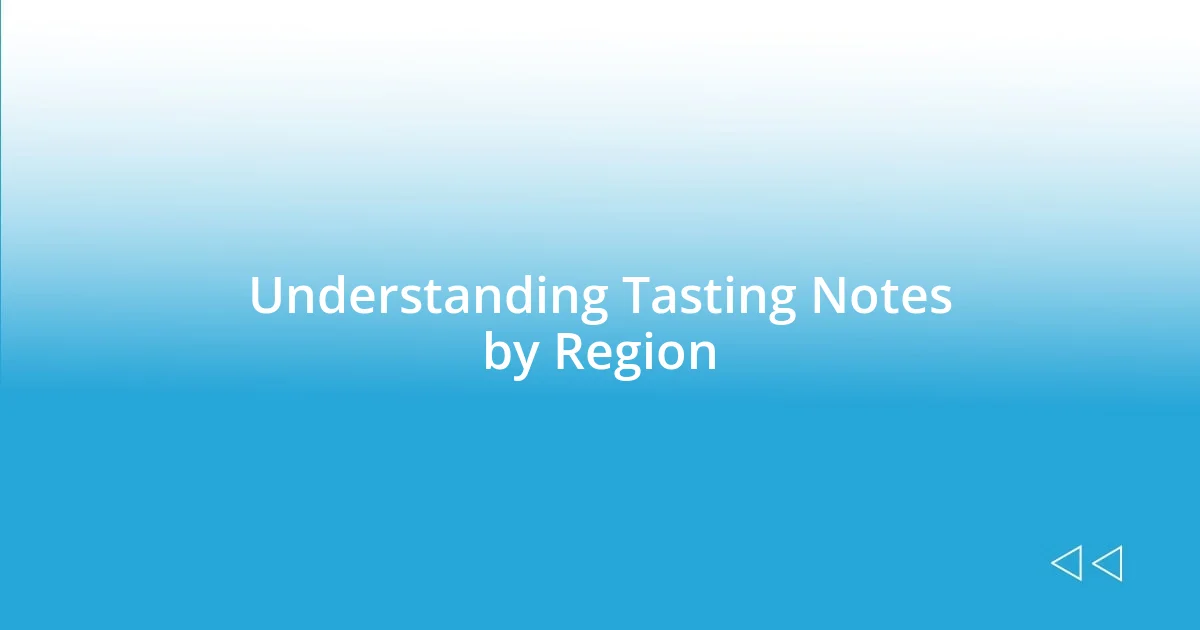Key takeaways:
- Whiskey regions significantly influence flavor profiles, with each area having distinct characteristics shaped by geography, climate, and local traditions.
- Exploring whiskey regions enhances appreciation for craftsmanship, as each bottle tells a story tied to its origins, culture, and production methods.
- Engaging with local culture, tasting multiple expressions from the same distillery, and attending whiskey events enrich the tasting experience and foster community connections.

Overview of Whiskey Regions
Whiskey regions are like distinct musical notes, each offering its own unique flavor profile influenced by geography, climate, and local traditions. I remember sipping a bourbon straight from Kentucky, feeling the warmth of the southern sun in every rich sip. Isn’t it fascinating how a single drink can tell a story of its origin?
In Scotland, for instance, the six whiskey regions—Speyside, Islay, Highland, Lowland, Campbeltown, and the Islands—each produce distinctive spirits that showcase their local terroir. When I tasted a smoky Islay whiskey, I could almost picture the rugged coastlines and swirling mists, making me wonder how many others have felt the profound connection to place while enjoying a glass. Have you ever considered how location plays a role in the flavors we love?
Each region not only highlights different ingredients and methods but also enriches the culture surrounding whiskey production. I vividly remember visiting a distillery in Ireland, where the stories of craftsmanship and passion were as intoxicating as the whiskey itself. It’s experiences like these that deepen my appreciation for the craft—don’t you feel the same when you explore the heart of a drink?

Importance of Whiskey Regions
Understanding whiskey regions goes beyond mere geography; it’s a journey into the essence of flavor and craftsmanship. When I first learned about the distinct characteristics of bourbon from the Kentucky region, I was taken aback by how the unique climate and local grains shaped its sweet notes. It’s incredible how something as simple as the environment can create such rich, varied flavors.
Each whiskey region tells a story, reflecting its local history, traditions, and people. I recall my trip to the Highlands, where the lush landscapes made every glass taste even more vibrant. For me, savoring whiskey isn’t just about the drink; it’s about connecting with the culture and passion behind it. Have you ever noticed how certain whiskeys transport you to the very place from which they came?
Understanding whiskey regions also enhances our appreciation of the craft behind each pour. I remember attending a tasting event that featured whiskeys from different regions. As I sampled each one, I realized that the differences weren’t just in flavor; they started to evoke memories and emotions tied to each region’s identity. In essence, whiskey regions enrich our experience, transforming each sip into an exploration of the world around us.
| Whiskey Region | Primary Characteristics |
|---|---|
| Kentucky | Bourbon, sweet vanilla, caramel notes |
| Islay | Peaty, smoky flavors, coastal brininess |
| Speyside | Fruity, floral, honeyed textures |
| Highland | Diverse flavors, robust and sometimes spicy |

Key Characteristics of Whiskey Regions
Each whiskey region possesses unique qualities that profoundly affect flavor and aroma, and it’s truly a joy to explore them. I’ll never forget cracking open a bottle of Tennessee whiskey—its smooth, mellow character was like an invitation to relax and enjoy the moment. The regional laws (like the Lincoln County Process used in Tennessee) directly influence how the whiskey is crafted, contributing to its signature profiles. This attention to detail always makes me reflect on the artistry behind every bottle we uncork.
Here’s a quick overview of some key characteristics of various whiskey regions:
- Kentucky: Home to bourbon; rich in caramel and vanilla flavors with a lingering sweetness.
- Tennessee: Smoother, with a charcoal filtering process that softens the taste and imparts a mellow finish.
- Scotland: Divided into distinct regions, each showcasing flavors from floral notes in Speyside to the intense peat from Islay.
- Ireland: Typically triple-distilled, offering smooth, light-bodied whiskeys that lean towards fruit and honey sweetness.
Exploring these differences reinforces my belief that whiskey is more than just a drink; it’s a representation of place and culture. I vividly remember being captivated by a bottle of Irish whiskey while at a pub in Dublin. With every sip, it felt like I was drawing from the very essence of Ireland itself, immersing me in the country’s rich storytelling tradition. It’s experiences like these that make whiskey tasting a profoundly personal journey.

Major Whiskey Producing Countries
When discussing major whiskey-producing countries, it’s hard not to start with the United States. I can still remember my first taste of a classic Kentucky bourbon—its warm, sweet notes danced on my palate, and I could almost envision the rolling hills of the Bluegrass State. The emphasis on corns in bourbon production creates flavors that are robust yet mellow. Isn’t it fascinating how the choice of grains can dramatically change the whiskey’s character?
Scotland is another heavyweight contender in the whiskey world. I recall standing in a distillery in Speyside, where the aromas of fermenting grains filled the air and made my heart race with excitement. The diversity in Scotch whiskey, from the peaty powerhouses of Islay to the lighter bodied expressions of the Lowlands, showcases the country’s rich whiskey heritage. How can such a small region produce such a vast array of flavors? It truly baffles me, yet it encourages exploration.
Next, we have Ireland, a country that produces some of the smoothest whiskeys I’ve ever encountered. I once enjoyed a glass of pot still whiskey at a cozy pub in Galway, where the honeyed sweetness and fruit-forward notes felt like a warm embrace. The triple distillation process uniquely shapes Irish whiskey, making it incredibly approachable for both new and seasoned whiskey drinkers. Do you ever find yourself drawn to specific regions based on not just flavor, but the stories behind each bottle? I know I do!

Regional Varieties and Styles
The variety of whiskey styles across regions creates a fascinating tapestry that reflects local traditions and preferences. For instance, when I visited Campbeltown, Scotland, I was struck by how the maritime climate influenced the flavor profiles of the whiskeys there; they had a briny depth that seemed to echo the sea. It’s moments like these that make me ponder how each bottle carries the fingerprints of its origins.
In contrast, sipping on a peaty Islay Scotch can be a completely different experience—a smoky embrace that takes me back to a chilly evening by a fire. I once hosted a tasting night with friends, and the distinctive flavors of Islay whiskies led to lively debates about smoke and earthiness. This divergence in flavor profiles makes exploring regional varieties an adventure that’s both personal and communal. Doesn’t it excite you to think about how every sip tells a story?
Then there’s the difference between the bold bourbons from Kentucky and the lighter, fruitier expressions from Ireland. I still remember the moment I savored my first bourbon neat—a warming sensation that felt like a gentle hug on a crisp fall day. Nothing beats that sense of discovery when you realize how different grains and distillation processes contribute to the unique character of each whiskey. Isn’t it remarkable how the regional styles guide our tasting adventures in unexpected directions?

Understanding Tasting Notes by Region
I’ve found that tasting notes can often be a reflection of the environment where the whiskey is produced. For example, when I explored the lush landscapes of Japan, the whiskeys I tasted were surprisingly delicate, with floral and fruity notes that felt almost poetic. It reminded me of sipping green tea under cherry blossom trees—such a serene experience! What do you think it is about the Japanese approach that brings these lighter, nuanced flavors to life?
When it comes to Canadian whiskies, I was taken aback by their smoothness and versatility. One winter, I enjoyed a glass of rye whiskey from Alberta, and its spicy notes coupled with hints of caramel sweetness felt like a cozy warm blanket on a snowy day. This made me realize how Canadian whiskey often blends multiple grains, leading to a complexity that’s exciting to explore. Have you ever noticed how the different grains can change the entire mood of a whiskey?
Visiting distilleries in Tennessee, I discovered the unique advantage of using charcoal to mellow out the spirits. I vividly recall attending a tasting where the rich, earthy characteristics of Tennessee whiskey paired beautifully with smoky BBQ—each sip enhancing the meal. It’s fascinating how regional techniques and food pairings can elevate the whiskey experience. How do your surroundings influence the way you appreciate different whiskies?

Tips for Exploring Whiskey Regions
When exploring whiskey regions, it’s essential to immerse yourself in the local culture. On my recent trip to Ireland, I made it a point to chat with the locals at a quaint pub. They shared stories about their favorite distilleries and recommended specific bottles that truly captured the essence of the region. I found that tasting whiskey is more than just about the drink; it’s about connecting with the narratives and traditions behind it. Have you ever felt a stronger bond with a beverage after hearing its backstory?
Another tip I swear by is to try different expressions from the same distillery during your travels. In Scotland, I had the chance to taste a flight of whiskies from one distillery that included everything from peaty to sherried varieties. It was eye-opening! The evolution of flavors from each cask offered insights into how subtle changes in aging and production can create a beautiful spectrum. Don’t you love how one distillery can tell multiple stories within its bottles?
Lastly, consider attending local whiskey festivals or tasting events whenever possible. I vividly remember a whiskey festival in bourbon country; it was a vibrant assembly of distillers, fans, and enthusiasts sharing their passion. It was great to sample rare releases while chatting with the artisans who crafted them. This sense of community around whiskey enhances the tasting experience and leaves you with connections that last long after the event. Have you ever made a memorable connection at a whiskey tasting?
















